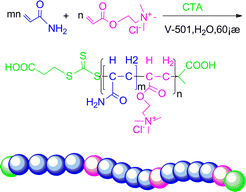Polyacrylamides and their derivatives are widely used as polyelectrolytes or polyampholytes. The morphology of polymer chains in solution plays an important role in their application. To illustrate the relationship between microstructure and properties, intrinsic viscosity as an apparent indication of the polymer chain hydraulic volume was focused on. A series of well-defined cationic polyacrylamides (C-PAMs) with dot-charges have been prepared via an aqueous living reversible addition fragmentation chain transfer (RAFT) polymerization, in which “dot-charges” means that any two cationic monomer units in the copolymer are not immediately connected each other. Water-soluble 4,4′-azobis (4-cyanovaleric acid) (V-501) and 2-(2-carboxyethyl-sulfanylthiocarbonylsulfanyl) propionic acid (CTA) were employed as the initiator and the chain transfer agent respectively and acryloyloxyethyltrimethylammonium chloride (DAC) acted as the cationic unit. The number of dot-charges and segment size between dot-charges were varied by adjusting the feed ratio and the polymerization time. The polymerization followed first order kinetics as indicated by gel permeation chromatography (GPC) characterization and the quantitative 1H-NMR analysis showed that DAC was incorporated into PAM chains as single dot-charges. The intrinsic viscosity of the well-defined C-PAMs solution was determined in an electrolyte solution and the result showed that end-groups with opposite charges in C-PAMs had serious effects on the expansion of polymer coil in aqueous solution. According to modified Rushing–Hester theory, a semi-empirical model based on molecular weight, chain length, cationic degree and charge distribution was established to explain the dependence of a dimensionless viscosity upon a dimensionless length and a dimensionless mass by regression analysis. The model will give theoretical suggestions for designing polyelectrolytes with desired viscosity.

You have access to this article
 Please wait while we load your content...
Something went wrong. Try again?
Please wait while we load your content...
Something went wrong. Try again?


 Please wait while we load your content...
Please wait while we load your content...